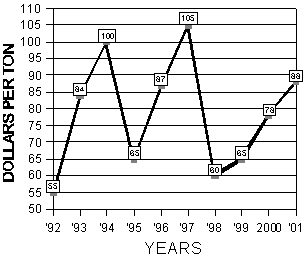Alfalfa Report
Yuma County, Arizona
September 10, 2001
Yuma County Office
2200 W. 28th Street, Ste. 102
Yuma, AZ 85364
(928) 726-3904
(928) 726-8472 FAX
Production Update:
PDF version, 40KB
Selecting an alfalfa variety: Alfalfa growers in Arizona have
over 40 varieties to choose from at planting time. Most of these varieties
are reported to have multiple pest resistance, high yield potential and
outstanding quality. Choosing an alfalfa variety involves answering the
following questions: 1) Which fall dormancy rating is desired? Usually,
nondormant and very nondormant varieties are most productive; 2) Which
pests will be major problems? 3) What yield performance data is available?
Potential new varieties should be planted on a small acreage on-farm and
compared to varieties of known performance before planting on a large
scale.
Nondormant
Alfalfa Varieties for Arizona 2001 PDF file, 42 KB
Insect Management: Beet armyworm and western yellowstriped armyworm are common pests in low desert alfalfa from June through September. Egg masses, covered with gray or white cottony scales, are deposited on the upper side of leaves. Eggs hatch in a few days and larvae reach full size in 2 to 3 weeks. Larvae pupate on or under the soil surface. Larvae appear smooth and are usually black with two prominent orange yellow stripes and many narrow stripes on each side. An intense black spot on the lateral margin of the first legless segment is a distinguishing characteristic. First instar larvae web terminal leaves together and skeletonize the leaves, later dispersing through the crop. Spiders and predacious bugs prey on larvae and larvae may be parasitized by Hyposoter exigua wasps. Monitor fields weekly using a sweep net and check fields 2 to 3 times per week if heavy populations begin to develop. Make 5 sweep counts at each of 4 to 5 locations in the field. Treat when there are 15 non-parasitized armyworms of more than ½ inch per sweep.
Weed Control: The performance of herbicides can be effected by
the mixing sequence of treatments requiring the addition of adjuvants.
Dry flowable formulations, for instance, can be difficult to dissolve
if the adjuvant is added before the herbicide is dissolved in water. The
mixing sequence on the label should be followed.
| Market Summary |
High
|
Low
|
Average
|
Off grade
|
| Past 2 Weeks (August 27 to Sept. 9, 2001) |
90
|
85
|
88
|
70-80
|
| Last Year (August 27 to Sept. 9, 2000) |
80
|
75
|
78
|
60-70
|
10 Year Summary (August 27 to Sept. 9, 1992-2001):

Issued in furtherance of Cooperative Extension work, acts of May 8 and June 30, 1914, in cooperation with the U.S. Department of Agriculture, James A. Christenson, Director Cooperative Extension, College of Agriculture and Life Sciences, The University of Arizona.
The University of Arizona is an equal opportunity, affirmative action institution. The University does not discriminate on the basis of race, color, religion, sex, national origin, age, disability, veteran status, or sexual orientation in its programs and activities.
Any products, services, or organizations that are
mentioned, shown, or indirectly implied in this web document do not imply
endorsement by The University of Arizona.
Information provided by:
Barry Tickes, btickes@ag.arizona.edu Extension Agent, Yuma County
Michael Ottman, mottman@ag.arizona.edu Agronomy Specialist
College of Agriculture, The University of Arizona.
Eric Natwick, etnatwick@ucdavis.edu UCCE Imperial County - Farm Advisor
University of California, Davis, CA.
Material written September 10, 2001.
Forages: Crop Mgmt | Soil Mgmt | Irrigation | Alfalfa Reports | Insects | Diseases | Weeds | Pesticides
Home | Other Crops | Forages
For more Arizona Production Ag Information:
Home | Cotton | Veggies| Forages | Grains | Citrus | Crop x Crop | Insects | Diseases| Weeds | Pesticides | News | Weather | Research | Photos | Contacts | General Info. | Site Map
Copyright © 2001 University of Arizona,
College of Agriculture and Life Sciences
Webmaster: Al Fournier (fournier@ag.arizona.edu)